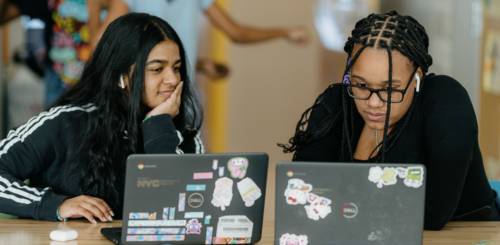STEM From Dance
Stories of Impact

Growing up with a mechanical engineer as a father, Yamilée Toussaint always felt like a career in STEM was within reach. But when she started working as an algebra teacher after college, she realized that her experience was an anomaly. Her female students often told her that they “just weren’t good” at math, and at times, it felt impossible to change their minds.
“The biggest barrier that I faced as a math teacher was convincing [my students] to believe after all these years of having not a great experience in math that they can do it well,” Toussaint recalled. In 2012, she founded STEM From Dance – a nonprofit that helps people of color, and specifically girls of color, find joy in STEM. “I saw at the time that girls just tend to not feel like math is a place they belong in,” Toussaint explained. “That’s really what we exist to change.”

Tapping into young people’s love for the arts, STEM From Dance uses dance to compel girls to enter the STEM fields by encouraging them to incorporate technology into their performances. Whether it’s figuring out how to design light up costumes through circuitry and programming, or using computer science to make graphics and animations to use as stage displays, these girls are able to see themselves as creators.
Over the past 11 years, STEM From Dance has served over 3,000 girls, with 800 girls participating in their programming in the past year. And while the organization was born in Brooklyn, STEM From Dance’s summer program now operates in 7 cities from Memphis, to Houston, to Denver.
We are poised to take what we built in Brooklyn and scale it to empower girls everywhere.Yamilée Toussaint, Founder & CEO
But STEM From Dance wouldn’t have a national presence without the support of their early backers, including Brooklyn Org. “It’s because of those who have supported and believed in us over the past decade that we’re in a position to grow and scale [right now],” Toussaint said. “Being able to get a multi-year grant gave us the foundation to be able to grow the organization and feel confident that we could sustain it because we knew we had this funding.”
Toussaint also attributes much of STEM From Dance’s success to the guidance of a mentor that Brooklyn Org connected her with through our nonprofit capacity building programs. “Her guidance has transformed the organization, as well as my leadership,” she recalled. “At that time, we wouldn’t have thought [we could] or maybe even afford to work with her.”

STEM From Dance has an ambitious goal for the coming years: By 2032, Toussaint hopes that it will serve one million girls by teaching their model to leaders in different cities that they’ll then bring to their local communities. In other words, STEM From Dance is set on growing a movement: “We are poised to take what we built in Brooklyn and scale it to empower girls everywhere.”